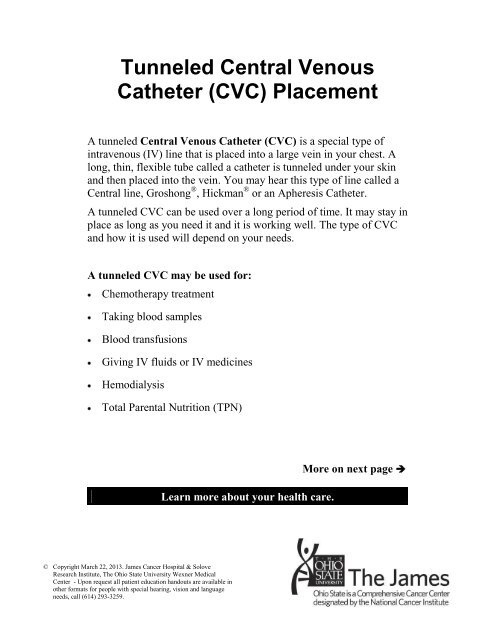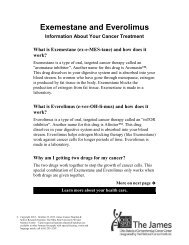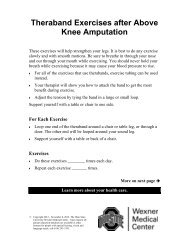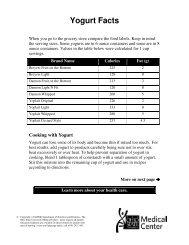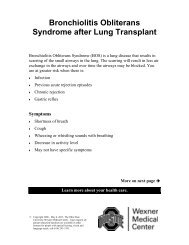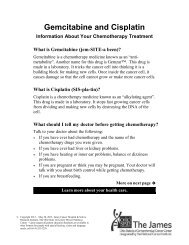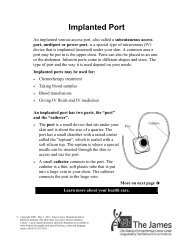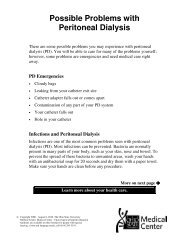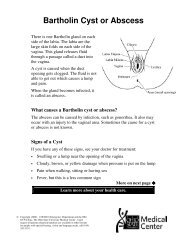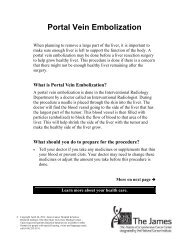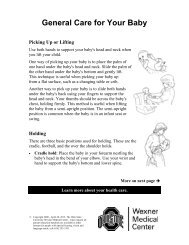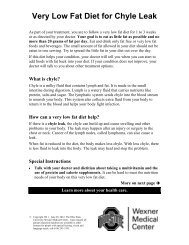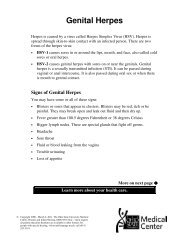Tunneled Central Venous Catheter (CVC) Placement - Patient ...
Tunneled Central Venous Catheter (CVC) Placement - Patient ...
Tunneled Central Venous Catheter (CVC) Placement - Patient ...
You also want an ePaper? Increase the reach of your titles
YUMPU automatically turns print PDFs into web optimized ePapers that Google loves.
<strong>Tunneled</strong> <strong>Central</strong> <strong>Venous</strong><br />
<strong>Catheter</strong> (<strong>CVC</strong>) <strong>Placement</strong><br />
A tunneled <strong>Central</strong> <strong>Venous</strong> <strong>Catheter</strong> (<strong>CVC</strong>) is a special type of<br />
intravenous (IV) line that is placed into a large vein in your chest. A<br />
long, thin, flexible tube called a catheter is tunneled under your skin<br />
and then placed into the vein. You may hear this type of line called a<br />
<strong>Central</strong> line, Groshong ® , Hickman ® or an Apheresis <strong>Catheter</strong>.<br />
A tunneled <strong>CVC</strong> can be used over a long period of time. It may stay in<br />
place as long as you need it and it is working well. The type of <strong>CVC</strong><br />
and how it is used will depend on your needs.<br />
A tunneled <strong>CVC</strong> may be used for:<br />
Chemotherapy treatment<br />
Taking blood samples<br />
Blood transfusions<br />
Giving IV fluids or IV medicines<br />
Hemodialysis<br />
Total Parental Nutrition (TPN)<br />
© Copyright March 22, 2013. James Cancer Hospital & Solove<br />
Research Institute, The Ohio State University Wexner Medical<br />
Center - Upon request all patient education handouts are available in<br />
other formats for people with special hearing, vision and language<br />
needs, call (614) 293-3259.<br />
Learn more about your health care.<br />
More on next page
Page 2<br />
Types of <strong>Tunneled</strong> <strong>Central</strong> <strong>Venous</strong> <strong>Catheter</strong>s<br />
There are different types of tunneled <strong>CVC</strong>s. Your doctor will talk with<br />
you about which type is best for you.<br />
A tunneled <strong>CVC</strong> may have a small cuff around the catheter. The<br />
cuff sits inside the skin tunnel. It helps to secure the catheter in<br />
place and prevent infection.<br />
The long thin hollow tubing that comes out of the skin is called a<br />
lumen. A tunneled <strong>CVC</strong> may have one lumen (single) or two or<br />
three separate lumens (double or triple lumens). A cap will cover<br />
the end of each lumen.<br />
Open-ended catheters have small clamps that close off the<br />
catheter when it is not in use. A Hickman or Apheresis catheter are<br />
types of open-ended catheters.<br />
Closed-ended catheters do not have clamps. Closed ended<br />
catheters have a special valve at the tip of the catheter that closes it<br />
off. A Groshong is a type of closed ended catheter.
How is a <strong>Tunneled</strong> <strong>CVC</strong> Placed?<br />
Page 3<br />
A tunneled <strong>CVC</strong> can be put in by a doctor in the operating room or<br />
in the Radiology Department.<br />
An IV will be put into your arm. You will be given medicine to<br />
help you relax and you may feel drowsy.<br />
The skin on your neck and chest will be cleaned with a special<br />
antibacterial soap.<br />
A numbing medicine will be given to decrease any discomfort.<br />
This medicine will numb the skin on your chest, neck and<br />
shoulder.<br />
Two small incisions are made during the procedure:<br />
One incision (insertion site)<br />
will be made at the bottom of<br />
your neck near your<br />
collarbone.<br />
A second incision (exit site)<br />
will be made on your chest a<br />
few inches above your nipple.<br />
This is where the catheter<br />
comes out of your body.<br />
A tunnel is then made under your<br />
skin between the two incisions.<br />
The catheter will be pulled<br />
through the tunnel and then put<br />
into a large vein just above your heart. This tunneling helps to hold<br />
the catheter in place.<br />
The incisions will be closed and held together by stitches, special<br />
surgical glue or steri-strips (small tapes). Both incisions are<br />
covered with a small gauze dressing. The catheter line will be<br />
taped to your chest to help hold it in place.
Page 4<br />
What to Expect After a <strong>Tunneled</strong> <strong>CVC</strong> <strong>Placement</strong><br />
You may have some bruising, swelling and tenderness where the<br />
catheter was put in. These symptoms should go away after 1 to 2<br />
days.<br />
You may have some mild discomfort where the <strong>CVC</strong> was placed.<br />
Talk to your doctor about what you can do to help with any pain or<br />
soreness.<br />
Your incisions should heal in about 7 to 10 days. .<br />
You will need to leave the gauze dressings on for the first 24<br />
hours after the <strong>CVC</strong> is placed. After 24 hours, remove the old<br />
dressing and put on a new dressing. If a dressing becomes loose or<br />
falls off, cover the <strong>CVC</strong> site and tape the dressing securely in<br />
place.<br />
Do not remove the incision steri-strips (small tapes). They will fall<br />
off on their own in about a week or more.<br />
Activity Limits with Your <strong>Tunneled</strong> <strong>CVC</strong><br />
A <strong>CVC</strong> should not change most of your daily activities. You do<br />
not need to wear special clothing.<br />
Do not swim or do activities that may cause the <strong>CVC</strong> site to<br />
become wet or dirty.<br />
You may take a shower with a tunneled catheter in place. Cover<br />
the <strong>CVC</strong> site with plastic wrap and tape the edges. You need to<br />
keep the dressing and the catheter area dry.<br />
Do not use sharp objects like scissors or a razor near your<br />
<strong>CVC</strong>.<br />
Do not do strenuous exercises or activities for a few weeks to<br />
allow your incisions to heal. These activities may cause the<br />
catheter to be pulled out. Talk to your doctor about any restrictions<br />
with activities, exercises and sports with a <strong>CVC</strong>.
How to Care for Your <strong>Tunneled</strong> <strong>CVC</strong><br />
Page 5<br />
Your <strong>CVC</strong> will need special care to keep it clean and working well.<br />
<strong>CVC</strong> care can be done by you, a caregiver or a nurse. You and your<br />
caregiver will be taught how to care for your tunneled <strong>CVC</strong> before<br />
you go home. This care includes:<br />
Cleaning and changing the dressing site<br />
Flushing the lumen(s)<br />
Changing the lumen(s) cap<br />
Call for Emergency Help (911) if you have:<br />
Shortness of breath<br />
Trouble breathing<br />
Chest Pain<br />
Severe bleeding from your incisions (hold firm pressure on the area<br />
and call for help)<br />
Call your doctor right away if you have any of the<br />
following:<br />
If your catheter accidently pulls out. Cover the area securely with a<br />
clean bandage (dressing), hold pressure on the site and then call<br />
your doctor.<br />
Increased bleeding or drainage from the incisions<br />
Swelling of the face, neck, chest or arm on the same side where the<br />
<strong>CVC</strong> was put in<br />
Dizziness<br />
Increased bruising, tenderness or redness at the incisions<br />
Fever of 100.4 degrees Fahrenheit (38 degrees Celsius) or higher<br />
Increased pain at the incisions<br />
Any other problems with your catheter


